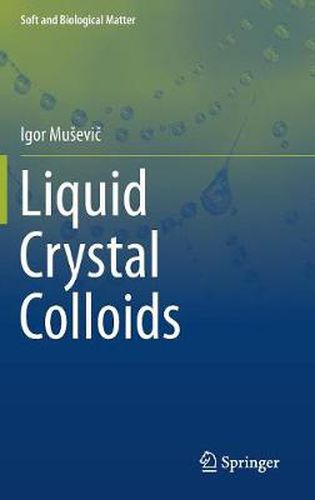Readings Newsletter
Become a Readings Member to make your shopping experience even easier.
Sign in or sign up for free!
You’re not far away from qualifying for FREE standard shipping within Australia
You’ve qualified for FREE standard shipping within Australia
The cart is loading…






This title is printed to order. This book may have been self-published. If so, we cannot guarantee the quality of the content. In the main most books will have gone through the editing process however some may not. We therefore suggest that you be aware of this before ordering this book. If in doubt check either the author or publisher’s details as we are unable to accept any returns unless they are faulty. Please contact us if you have any questions.
This book brings together the many concepts and discoveries in liquid crystal colloids contributed over the last twenty years and scattered across numerous articles and book chapters. It provides both a historical overview of the development of the field and a clear perspective on the future applications in photonics.
The book covers all phenomena observed in liquid crystal colloids with an emphasis on experimental tools and applications of topology in condensed matter, as well as practical micro-photonics applications. It includes a number of spectacular manifestations of new topological phenomena not found or difficult to observe in other systems. Starting from the early works on nematic colloids, it explains the basics of topological defects in ordered media, charge and winding, and the elastic forces between colloidal particles in nematics. Following a detailed description of experimental methods, such as optical tweezing and particle tracking, the book eases the reader into the theoretical part, which deals with elastic deformation of nematic liquid crystals due to inclusions and surface alignment. This is discussed in the context of basic mean field Landau-de Gennes Q-tensor theory, with a brief explanation of the free-energy minimization numerical methods. There then follows an excursion into the topology of complex nematic colloidal structures, colloidal entanglement, knotting and linking. Nematic droplets, shells, handlebodies and chiral topological structures are addressed in separate chapters. The book concludes with an extensive chapter on the photonic properties of nematic dispersions, presenting the concept of integrated soft matter photonics and discussing the concepts of nematic and chiral nematic microlasers, surface-sensitive photonic devices and smectic microfibers.
The text is complemented by a large bibliography, explanatory sketches and beautiful micrographs.
$9.00 standard shipping within Australia
FREE standard shipping within Australia for orders over $100.00
Express & International shipping calculated at checkout
This title is printed to order. This book may have been self-published. If so, we cannot guarantee the quality of the content. In the main most books will have gone through the editing process however some may not. We therefore suggest that you be aware of this before ordering this book. If in doubt check either the author or publisher’s details as we are unable to accept any returns unless they are faulty. Please contact us if you have any questions.
This book brings together the many concepts and discoveries in liquid crystal colloids contributed over the last twenty years and scattered across numerous articles and book chapters. It provides both a historical overview of the development of the field and a clear perspective on the future applications in photonics.
The book covers all phenomena observed in liquid crystal colloids with an emphasis on experimental tools and applications of topology in condensed matter, as well as practical micro-photonics applications. It includes a number of spectacular manifestations of new topological phenomena not found or difficult to observe in other systems. Starting from the early works on nematic colloids, it explains the basics of topological defects in ordered media, charge and winding, and the elastic forces between colloidal particles in nematics. Following a detailed description of experimental methods, such as optical tweezing and particle tracking, the book eases the reader into the theoretical part, which deals with elastic deformation of nematic liquid crystals due to inclusions and surface alignment. This is discussed in the context of basic mean field Landau-de Gennes Q-tensor theory, with a brief explanation of the free-energy minimization numerical methods. There then follows an excursion into the topology of complex nematic colloidal structures, colloidal entanglement, knotting and linking. Nematic droplets, shells, handlebodies and chiral topological structures are addressed in separate chapters. The book concludes with an extensive chapter on the photonic properties of nematic dispersions, presenting the concept of integrated soft matter photonics and discussing the concepts of nematic and chiral nematic microlasers, surface-sensitive photonic devices and smectic microfibers.
The text is complemented by a large bibliography, explanatory sketches and beautiful micrographs.